The Megalodon: Exploring the Ocean's Great Predator
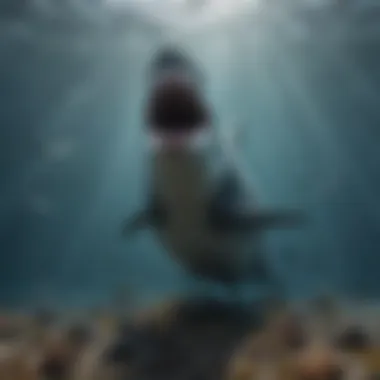
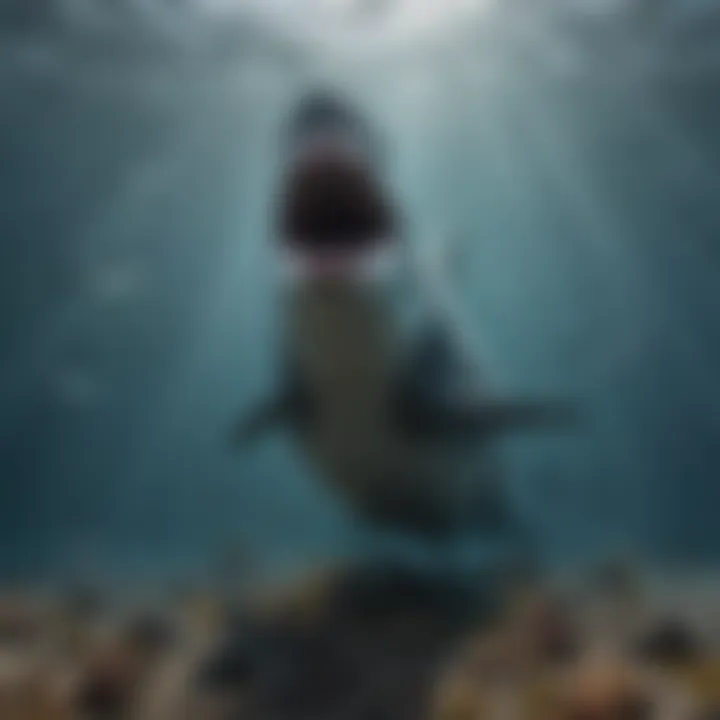
Nature Topic Overview
Megalodon, the giant shark that once ruled the oceans, is an incredible part of our planet's history. This massive predator swam in the seas approximately 23 million to 3.6 million years ago. Believed to be as long as a bus and weighing as much as a whale, the megalodon was not just any shark; it was the king of the ancient waters. Understanding this fascinating creature offers us a glimpse into a world that was, and helps us see how important sharks, and the ocean, are today.
The life of the megalodon is marked by its strength, its hunting abilities, and even its influence on other marine species. From its impressive teeth to its preferred habitats, there’s a lot to uncover about this ocean giant.
Fun Facts and Trivia
Did you know that the megalodon had teeth that were up to seven inches long? Imagine trying to visit the dentist with teeth like that! Here are some more interesting tidbits:
- Size Matters: While a great white shark is around 15 feet long, the megalodon could reach lengths of over 50 feet!
- Feeding Frenzy: This predator primarily fed on whales, seals, and even large fish. Its jaw was so strong that it could crush bones.
- Ancient Relatives: The megalodon is related to the modern great white shark, even though they are quite different in size.
- Gone Too Soon: Although it ruled the seas for millions of years, the megalodon went extinct, and scientists are still trying to figure out why.
Visuals and interactive elements like infographics showing megalodon sizes compared to today’s sharks can make learning about these facts even more engaging for kids.
Wildlife Explorations
Megalodon was not the only fascinating creature swimming around in ancient waters. Other species included giant sea turtles and massive dolphins. Knowing about these creatures enriches our understanding of how different animals interact in their ecosystems.
Related Species
- Great White Shark: A distant relative, still prowling the deep blue today.
- Basking Shark: The second-largest shark, known for its filter-feeding habits.
- Sperm Whale: These whales were likely prey for the megalodon; they can dive deep and are a crucial part of ocean ecosystems.
Kids can enhance their learning by participating in activities like quizzes that challenge their knowledge of marine life!
Environmental Awareness
Learning about megalodon teaches us why protecting our oceans is vital. Sharks play a key role in maintaining balance in marine ecosystems. They help control fish populations, promoting healthy ocean habitats.
How You Can Help
Here are some simple ways children can help protect nature:
- Reduce Plastic Use: Using reusable bags and bottles keep oceans clean.
- Share Knowledge: Talk to friends and family about the importance of sharks and marine life.
- Join Clean-Up Events: Participate in local beach clean-ups to keep marine habitats safe.
DIY Nature Activities
Get hands-on and dive into nature-inspired projects! Try out these fun activities:
- Create a Megalodon Tooth Craft: Using cardboard and paint, children can make their own megalodon tooth replica.
- Ocean Diorama: Build a mini ocean habitat using a shoebox and craft materials. Include megalodon models for an added touch!
- Scavenger Hunt: Organize a scavenger hunt for marine-related items in your backyard or at the beach to create awareness about local wildlife.
Exploring nature doesn’t always require a trip out—sometimes it can be done right in your home! Encouraging outings to local aquariums or science museums enriches the learning experience too.
By studying these fascinating creatures and understanding their significance, people of all ages can be inspired to care for our marine environments.
Prologue to the Megalodon
The megalodon is not just another extinct creature; it has captured the imagination of many as a symbol of the ocean's might and mystery. This section of the article sets the stage for an enthralling exploration of this colossal predator, enticing readers to ponder what life might have been like millions of years ago beneath the waves. Understanding the megalodon is crucial because it offers insights into both ancient marine ecosystems and the evolutionary pathways that led to today's sharks.
Definition of the Megalodon
The megalodon, scientifically known as Carcharocles megalodon, was a prehistoric giant shark that roamed the oceans from around 23 million years ago to about 3.6 million years ago. The name itself means "big tooth" in Greek, which aptly describes one of its most striking features. Imagine a shark so large that its mouth could measure more than 10 feet wide! The megalodon is generally believed to have measured anywhere from 40 to possibly over 60 feet long, making it one of the largest predators to have ever lived in the sea.
Megalodon's teeth were large enough to crush bones and tear through flesh with ease. These formidable teeth can reach sizes of over 7 inches in length, showcasing its effectiveness as a top predator in the ocean. But, interestingly, megalodon was not just about size. This creature was agile and capable of quick bursts of speed, thanks to its powerful, streamlined body. It commanded respect from all other marine life during its reign.
Historical Context
To truly appreciate the megalodon, one must consider its historical backdrop. The megalodon existed during the Cenozoic Era, particularly in the late Miocene and early Pliocene epochs. During this time, the world underwent significant geological and climatic changes. The oceans were different; they were teeming with marine life like whales, dolphins, and various fish species that would eventually become part of the megalodon's diet. The evolution of large marine animals coincided with the rise of megalodon, and it adapted perfectly to its environment.
Through fossil records and studies, scientists have pieced together how these giants thrived. Megalodon fossils have been discovered across various continents — from North America to Europe, showcasing its wide distribution in the ancient oceans. Its existence reflects a vibrant and diverse marine ecosystem, illustrating the balance of predator and prey during that era.
The study of megalodon not only allows us to delve into ancient ocean life but serves as a reminder of how species adapt and evolve in relation to their surroundings, and how those environments change dramatically over time. With every new discovery, the megalodon continues to intrigue scientists and enthusiasts alike, unveiling layers of history, ecology, and the delicate web of life that once existed beneath the ocean's surface.
Physical Characteristics
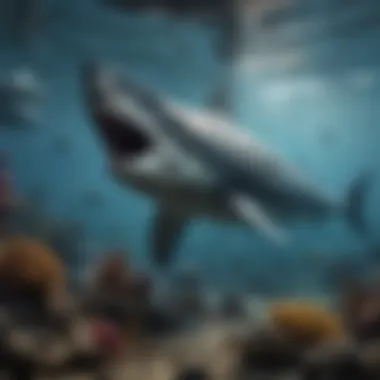
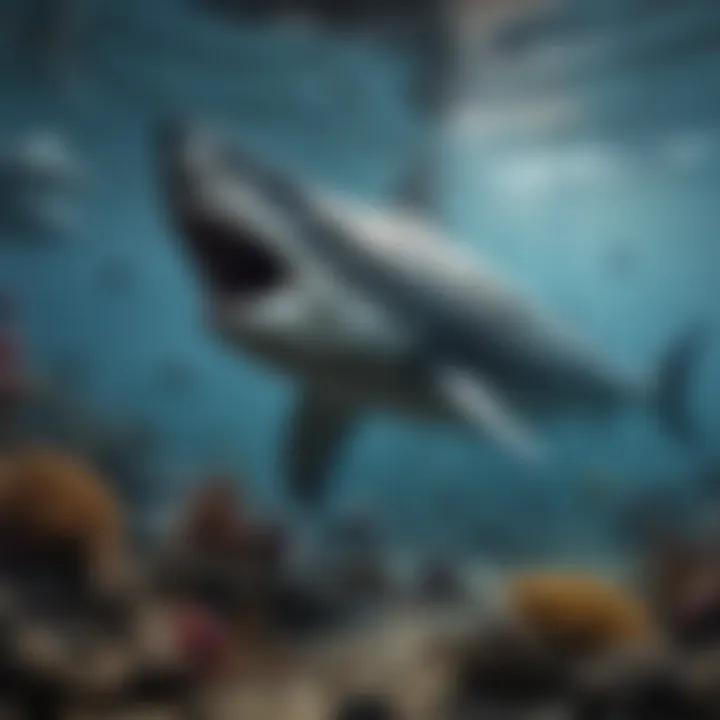
Understanding the physical characteristics of the megalodon is essential for grasping what made this predator such a formidable force in its oceanic environment. These attributes not only reflect its evolutionary success but also provide insight into its hunting capabilities, survival strategies, and interactions with other marine life. When we look closely, we can see how each characteristic played a significant role in its life and eventual demise.
Size and Length Estimates
Megalodon is often referred to as one of the largest marine predators ever to have existed. Estimates suggest that its length could reach up to 60 feet, with some hypotheses even claiming it might have grown beyond that! This colossal size did more than impress; it granted the megalodon unparalleled strength and reach, allowing it to dominate its surroundings.
- Comparison: To visualize this size, imagine a school bus, which is about 40 feet long, and picture the megalodon being even longer. It's like comparing a giant whale to a small fish.
- Growth Stages: During its early life, megalodons were already formidable, growing rapidly. They started small, maybe around 6.6 feet, and exploded in size as they aged.
The sheer mass of the megalodon would have allowed it to take down large prey, reinforcing its position as a top predator. Its size was not merely for show; it had impressive biological advantages that allowed it to thrive in the competitive marine ecosystems of its time.
Dentition and Jaw Structure
The jaw of the megalodon is as impressive as its size. It's believed to have had the most powerful bite force of any known animal. Fossils of its teeth, which could measure over 7 inches long, paint a picture of a creature that hunted with precision.
- Teeth Structure: Unlike other sharks, megalodon teeth are broad and with serrated edges, which allowed for a sawing action when biting into prey. Their design was perfect for gripping and tearing.
- Jaw Mechanism: The jaw was massive and flexible, capable of opening wide enough to accommodate enormous prey. This adaptability meant it could tackle everything from large fish to whales.
With such formidable dental attributes, the megalodon exemplified how teeth could be both tools for survival and weapons of destruction, showcasing its finely-tuned hunting strategies.
Skin and Body Structure
The skin of the megalodon was likely rough and tough, similar to any modern shark. Shark skin is made up of tiny scales called dermal denticles. These provide not only protection but also help with swimming efficiency.
- Coloration and Camouflage: While specific details about megalodon skin color remain elusive, scientists speculate it may have used color for camouflage, blending in with the ocean depths.
- Hydrodynamic Body Shape: Its body was streamlined, which allowed it to move quickly through water. This was crucial for a predator that needed to ambush its prey.
Overall, the skin and body structure of the megalodon were prime examples of evolution’s design for efficiency and effectiveness in a predatory lifestyle.
"The megalodon’s size, teeth, and body structure combined make it one of the most efficient predators ever to have ruled the ancient oceans."
Understanding these physical characteristics sheds light on why the megalodon was such a dominant figure in prehistoric marine life. From its overwhelming size to its specialized teeth and efficient body, each aspect contributed to its success as a predator. The fascinating elements we have explored are crucial for appreciating this ancient creature's significance in the greater context of marine evolution.
Habitat and Distribution
Understanding the habitat and distribution of the megalodon is crucial for grasping how this colossal predator thrived in ancient oceans. The megalodon, as one of the largest and most fearsome sharks ever, didn't just roam aimlessly through the waters; its habitat was intricately tied to its feeding habits, breeding practices, and survival strategies. Knowing where it lived gives us a deeper appreciation of its ecological role and how it interacted with other marine species.
Geological Periods of Existence
The megalodon existed during the Cenozoic Era, specifically thriving from approximately 23 to 3.6 million years ago. This significant timeline roughly corresponds to the Miocene and Pliocene epochs. During these periods, the Earth experienced substantial changes in climate and geography, which directly influenced marine life, including the megalodon.
- Miocene Epoch (23 to 5.3 million years ago): This era saw the oceans warm considerably. Coral reefs flourished, providing abundant food and habitats for marine species, including the megalodon, which likely enjoyed rich hunting grounds along continental shelves.
- Pliocene Epoch (5.3 to 2.6 million years ago): As the climate cooled, we see evidence of a shift in megalodon habitats. They extended their reach into deeper waters, adapting to the changing environment while still occupying coastal areas for breeding and feeding.
These geological periods shaped the distribution of megalodon populations, ultimately determining their success as apex predators in a competitive ocean ecosystem.
Preferred Environments
Megalodons preferred a variety of marine environments that catered to their predatory lifestyle. They were not limited to a single habitat but rather occupied diverse regions. Here are the key environments where megalodons likely thrived:
- Coastal Waters: Shallow coastal areas provided ample opportunities for hunting smaller fish and marine mammals. Think of it as their favorite buffet where the options were plentiful.
- Open Ocean: They were also seen in deeper waters, where they could hunt larger prey like whales. These vast expanses were like nature's own arena for displaying their predatory prowess.
- Estuaries: Areas where fresh and saltwater meet were likely important for juvenile megalodons. These nursery areas provided shelter from larger predators, so baby megalodons could grow and develop in relative safety.
- Continental Shelves: These regions, rich in nutrients and biodiversity, offered a smorgasbord of food sources, making them ideal locations for feeding.
*"The megalodon was not just a shark; it was a versatile predator navigating the world's oceans, adapting to whatever opportunities arose."
In summary, the habitat and distribution of the megalodon were marked by adaptability and strategic choices. Understanding these factors helps us appreciate the significant ecological role this tremendous predator played in its ancient marine world.
Feeding Habits
Understanding the feeding habits of the megalodon is crucial for grasping how this magnificent predator acted within its environment. The megalodon's mouth was truly a sight to behold. Consider it as the Ferrari of the ocean – powerful and efficient, designed for speed and strength. Its enormous jaws, lined with sharp, serrated teeth, were optimally crafted to tackle its favorite meals. Learning about what the megalodon ate and how it hunted helps painting the picture of this ancient giant's role in prehistoric ecosystems.
Dietary Preferences
The megalodon was not a picky eater, which is a hallmark of many top predators. Primarily, its diet would have revolved around large marine animals. Some favorites likely included:
- Whales: The sheer size of megalodon would lead researchers to speculate that it often hunted whales, notably larger species.
- Dolphins: Fast and agile, dolphins would present a challenge but were certainly a part of the megalodon diet.
- Other Sharks: The megalodon might have even eaten smaller sharks, competing for dominance in the waters of its time.
- Sea Turtles: These creatures also offered a rich source of protein, especially when nesting.
It's fascinating to think how the megalodon’s diet shaped its environment. It wasn’t just about feeding; it involved keeping the populations of other species in check, creating a balance in the marine ecosystem.
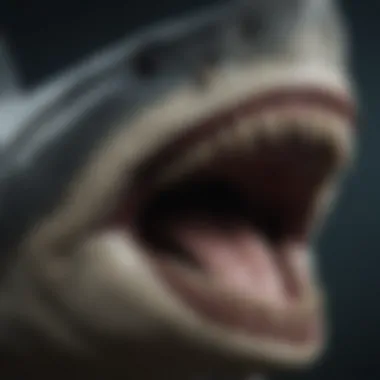

Hunting Techniques
When it comes to hunting techniques, the megalodon was likely a mix of stealth and raw power. Imagine it gliding through the waters like a heavyweight champion in the ring—always calculating the next move, ready to unleash its might. Here are some key techniques they might have employed:
- Ambush Predation: Much like how a cat waits patiently for its next meal, the megalodon may have often stalked its prey silently, only to strike with lightning speed.
- Brute Force: Once it locked onto its target, the megalodon could use its size and weight to its advantage. A single bite from its 7-inch teeth was enough to incapacitate large prey instantly.
- Group Behavior: There's evidence that suggests megalodons might have hunted in groups, similar to how orcas operate today. This team strategy could have allowed them to take down larger animals much more efficiently.
“A predator’s role isn’t solely about eating, it’s about managing the dynamics of the ecosystem, ensuring the health of the ocean.”
In this way, the feeding habits of the megalodon help illustrate its impact on marine life millions of years ago, drawing connections to how its successors—modern sharks—play out similar roles today.
Social Behavior
Understanding the social behavior of the megalodon sheds light on its ecological role and survival strategies. Social interactions among predators can impact their hunting efficiency and reproductive success. While much of what we know about megalodons stems from fossil records and scientific inference, theorizing their social dynamics opens a fascinating window into how these colossal sharks may have lived and interacted with their environment.
Mating Rituals
Mating in marine life can be as intricate as a well-choreographed dance, and it’s likely the megalodon was no different. Picture two massive creatures gliding through the depths, engaging in behaviors that signal courtship. The exact details of megalodon mating rituals remain a bit of a mystery. However, studies of modern sharks give us some hints.
- Aspects of Attraction: Much like today’s sharks, megalodons may have used body language, such as tail slapping or circling, to attract mates. Male megalodons may have showcased their size and strength to appeal to females—after all, bigger often means better!
- Breeding Grounds: It’s possible that megalodons gathered in specific areas for breeding, similar to how certain shark species congregate today. Warm coastal waters might have served as these nurseries, where they could give birth safely.
Mating rituals, if they existed, served an important function. They ensured gene diversity and the continuation of the species, vital for a creature that thrived in a competitive ocean environment. It’s a delicate balance between survival and procreation.
Territorial Aspects
Territorial behavior can provide profound insights into an animal’s lifestyle and habits. Unlike some fish that roam far and wide, megalodons might have established areas that they defended against others.
- Territory Marking: Some species mark their territory using scents or gestures. While it’s tough to say for sure how megalodons communicated their territory, they may have engaged in displays of aggression or size to ward off intruders.
- Resource Control: By establishing territories, megalodons could ensure access to plentiful resources, like schools of fish or evolving prey. This would directly enhance their chances of survival, especially when food was scarce.
In essence, recognizing the possible territorial behavior of megalodons adds a layer of complexity to their existence. It is not just about hunting; it is also about mastering their environment—claiming space to thrive within the vast ocean.
"Understanding the social interactions of ancient predators like the megalodon helps us to imagine their lives in a way that fossil records alone cannot."
In closing, the social behaviors of the megalodon are as fascinating as they are essential for grasping their place in the marine ecosystem. They influenced mating success, territory establishment, and resource management, painting a broader picture of life beneath the waves.
Scientific Exploration
The study of megalodons unveils a treasure trove of insights about these ancient giant sharks, their evolution, and their environment. Understanding how scientists explore megalodons sheds light on their importance in marine ecosystems and brings us closer to deciphering our planet's historical oceanic narratives. This exploration is integral in not just piecing together how these creatures lived, but also in grasping the broader implications for current marine life.
Fossil Discoveries
Fossils of the megalodon have been discovered in many places around the world, from the coasts of North America to Europe and Australia. The most commonly found remains are teeth, which can be as large as a human hand — imagine that! These teeth are crucial for scientists as they provide a wealth of information. Studying the size and shape of the teeth gives clues about the megalodon's diet and hunting practices. For example, a hefty tooth likely indicates it fed on large marine animals, including whales.
It’s not just about the teeth, however. Researchers also look for vertebrae and jaw fragments, which help to reconstruct the megalodon's overall size and body structure. The fossil evidence tells a compelling story of adaptation and survival.
"Fossils are nature's time capsules, holding secrets from millions of years ago."
Through fossils, we understand more not just about the megalodon, but the ecosystems they were part of. The information gained from these fossil discoveries helps fill gaps in our knowledge about the ocean ecosystem and how it has changed over time.
Research Techniques
In studying megalodons, scientists employ various techniques that blend traditional fossil analysis with cutting-edge technology. These techniques can broadly be categorized into a few essential methods:
- Geological Surveys: Scientists conduct surveys of sedimentary layers where fossils might be found, mapping out areas with a higher probability of megalodon remains.
- 3D Modeling and Reconstruction: Using technology, researchers create three-dimensional models of fossils. This helps them analyze features that would be difficult to see otherwise, allowing for a better understanding of megalodon anatomy.
- Isotope Analysis: This sophisticated method analyzes the chemical composition of fossilized remains. By studying isotopes, scientists can infer the diet and migratory patterns of megalodons.
- Collaborative Research: Working alongside geologists, oceanographers, and paleontologists, researchers share insights that enhance our understanding of the megalodon's life.
Modern techniques blend skills from various fields, underscoring how interdisciplinary collaboration is essential to unlocking the mysteries of the megalodon. By piecing together all these pieces, scientists can illuminate not only the life of the megalodon itself but also its role in the grand story of ocean life.
Extinction Theories
Understanding how the megalodon went extinct is crucial to piecing together the history of ocean life. These theories shine a light on the environmental dynamics during the time the megalodon existed and offer insights into the interplay between ancient marine creatures. Importantly, discussing extinction theories helps us learn about biodiversity loss today, enabling us to appreciate the fragility of ecosystems. By examining these concepts, we gain a clearer perspective on the impact of climate change, competition among species, and other factors that could lead to species decline.
Climate Change Factors
Climate change played a significant role in the megalodon's demise. This colossal creature thrived around 23 million years ago, during a warmer period in Earth's history. However, as the climate began to cool around 5 million years ago, ocean temperatures dropped, changing the habitats and food sources that the megalodon relied on. Think about it: warmer waters not only helped sustain large prey like whales but also influenced where they lived. With shifting currents and declining temperatures, megalodons faced nutritional challenges.
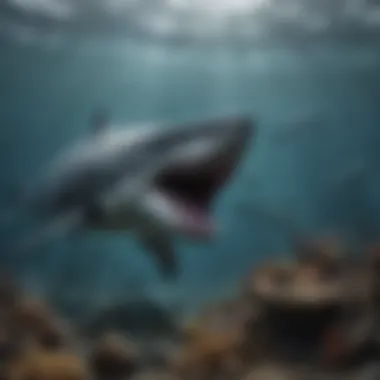
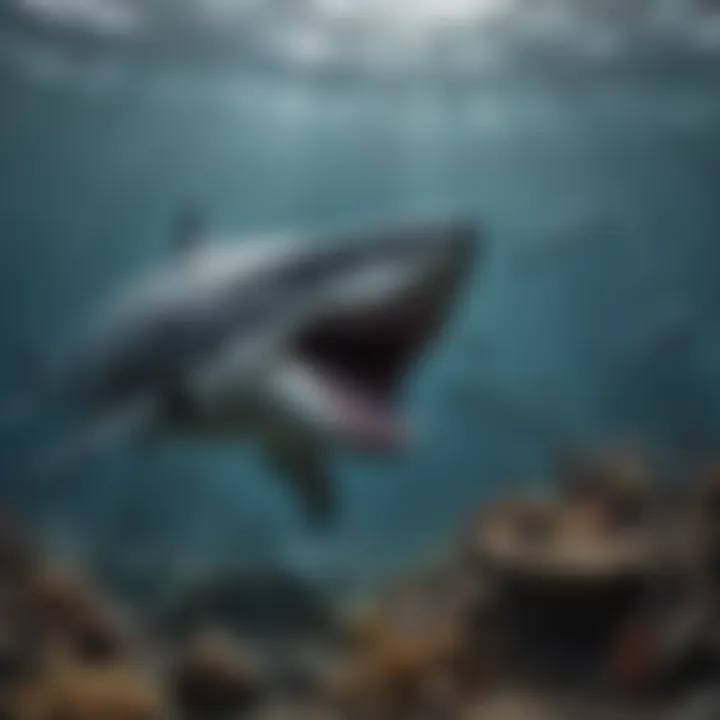
On top of this, as sea levels fluctuated and ice caps expanded and contracted, the coastal environments started to change. Coral reefs and underwater landscapes altered, impacting the megalodon’s hunting territory. Some scientists believe that if they could no longer find their preferred prey or adapt to the changing environments, it could have significantly contributed to their decline.
"Species that can adapt rapidly thrive, while others succumb to changes they cannot navigate." These words underscore the reality faced by many animals during climatic shifts.
Competition with Other Species
As the environment transformed, the megalodon also faced stiffer competition from emerging species. New predators like the great white shark began to evolve and adapt to the changing conditions. These new competitors were agile and smart, carving out niches that were once exclusive to the megalodon.
Moreover, as smaller marine mammals and fish evolved, they too began to share the same food resources. Imagine two giant children wanting the same toy; eventually, one might give up if things get too tough. The megalodon, while powerful, may have found itself outcompeted in an increasingly crowded ocean full of hungry mouths.
Cultural Impact
Understanding the cultural impact of the megalodon gives us a look at how this ancient predator has shaped our imagination, inspired stories, and influenced our perception of marine life. In societies around the globe, the megalodon stands not just as a symbol of the ocean’s might but also as a lesson in nature's complexity.
The giant shark has become a staple in various narratives, sprouting from folklore to literature, and it plays a significant role in how we see shark species today. People often associate the megalodon with adventure and danger, feeding into both scholarly research and its position in popular culture. Thus, it’s vital to examine these city-sized, serrated-toothed creatures in how they resonate with our artistic expressions and societal themes.
Megalodon in Literature
The megalodon has made waves through the pages of many books since its discovery.
- Influence in Fiction: Authors have hardly missed a chance to portray this colossal predator in their works. For example, in Michael Crichton's novel "Sphere," the mention of prehistoric creatures like the megalodon adds a chilling narrative depth, intertwining science fiction with a haunting possibility that these giants still lurk in the depths.
- Children’s Literature: The megalodon has found its way into children’s books as well. Stories often depict it as a misunderstood creature of the ocean, teaching young readers valuable lessons about respect for nature. This often leads to discussions about marine conservation, encouraging kids to protect ocean life.
This kind of literature not only entertains but also educates about marine ecosystems and the importance of biodiversity.
Representation in Media
From films to documentaries, the megalodon has made its mark in media, often casting a long shadow on the screen.
- Documentaries: Shows like Monsters of the Deep highlight the scientific research behind megalodon fossils and their habitats. These documentaries provide insights into deep-sea ecosystems, introducing viewers—especially young ones—to the fascinating world beneath the waves.
- Movies: The megalodon could be seen in blockbuster films, including The Meg, which revs up excitement with thrilling encounters between humans and this formidable creature. While these portrayals may embellish the truth, they pique curiosity about the ocean and its inhabitants, sparking interest in marine biology among younger audiences.
- Social Media: Platforms like Facebook and Reddit further amplify interest, where fans discuss theories and share concepts about megalodon sightings or research. This not only keeps the conversation alive but connects diverse groups of people around the shared wonder of oceanic mysteries.
Modern Comparisons
When discussing the megalodon, a magnificent yet fearsome beast, we cannot overlook how it fits into today's marine world. Understanding its relationship to current shark species and its ecological significance helps us appreciate not only what was lost in its extinction but also what we stand to gain in actively protecting marine life today.
Relationship to Current Shark Species
Though the megalodon is a thing of the past, its legacy lives on through today's sharks. Current species, like the great white shark and the tiger shark, possess some traits reminiscent of the megalodon. For instance:
- Size and Power: The great white shark can reach lengths of up to 20 feet, whereas the megalodon is estimated to have grown over 60 feet long. However, the powerful bite force of a great white is something historians and biologists want to study to understand how megalodon may have hunted.
- Dietary Habits: Both megalodon and current sharks are apex predators; they play crucial roles in their ecosystems. The great white primarily eats seals and large fish, while megalodon likely feasted on whales and other large marine animals.
- Behavioral Patterns: There's still debate on how megalodons hunted, whether solo or in groups. Current evidence from great whites shows they can work together and even use tactics to capture prey—a fascinating insight for those pondering how megalodon might have lived.
Ecological Significance
The megalodon was a keystone species, and understanding it heightens our awareness of ecological balance. With the extinction of such giant predators, certain shifts occurred in the oceanic food web. Without megalodons, smaller marine species proliferated, which drastically altered marine ecosystems where they dwelled. Here are some vital points about ecological significance:
- Predator-Prey Dynamics: The megalodon maintained populations of other marine animals. Without it, there could be an overpopulation of certain species, ultimately leading to ecological disaster.
- Biodiversity: The absence of megalodon in modern oceans can affect species and their habitats. The interactions and balances that once existed have shifted, changing everything from local ecosystems to biodiversity as a whole.
- Modern Conservation Efforts: By studying megalodon, scientists strive to protect current shark species. Understanding what led to their extinction aids in implementing effective conservation methods for today's sharks, which face threats from overfishing and habitat loss.
"Understanding the past gives us the tools to advocate for the future. Protecting marine life means securing the health of our oceans for generations to come."
In exploring these comparisons between the megalodon and modern shark species, we grasp a clearer perspective on ecological importance, which can inspire both children and adults alike to engage in marine conservation efforts. Such knowledge instills appreciation for our oceans and a resolve to safeguard them.
Megalodon in Fantasy and Myth
The megalodon, once the top predator in the ocean, has not only captured the imagination of scientists but has also woven itself into the fabric of stories told throughout generations. Its immense size and ferocity have fueled various legends and myths, sparking curiosity and even fear. By exploring this connection to fantasy and myth, we can see how such ancient creatures are perceived, shaping our understanding of marine life and conservation efforts today.
Legends and Folklore
Megalodon's colossal form provides fertile ground for legends across cultures. In certain coastal communities, tales of sea monsters inspired by the megalodon have passed down through oral tradition. For example, fishermen sometimes recount stories of enormous shadows beneath their boats, claiming those shadows belong to the mighty megalodon, lurking just out of sight.
These legends often serve a greater purpose, acting as cautionary tales. They remind people of the dangers of the sea and the unknown that lies beneath the waves. Some tribes even use the megalodon as a symbol of strength and resilience, teaching younger generations to respect nature's power.
Much like how ancient cultures explained their surroundings, the megalodon has become a metaphor for the unpredictable aspects of life. Whether it’s in a thrilling adventure story or a local legend, these tales paint a picture of both wonder and fright. They draw in young minds, making them ponder what lurks beneath the ocean surface, and in turn, foster a fascination with marine biology and conservation.
Influence on Marine Conservation Narratives
The story of the megalodon has far-reaching implications for marine conservation today. Its mythological status amplifies the conversation around protecting oceanic ecosystems. The idea of such a grand creature once roaming the seas can spark a sense of urgency in the effort to safeguard current marine life.
"Understanding the past helps us protect our oceans today."
By utilizing the megalodon in educational materials, artists and conservationists often engage children and adults alike, highlighting issues such as overfishing and habitat destruction. This creature can serve as a powerful emblem for preservation efforts, symbolizing what was lost and what needs to be preserved.
In many ways, stories about the megalodon compel people to delve deeper into the relationship humans have with the ocean. They serve to raise awareness and inspire action, pledging to protect today's vulnerable species. By learning about the megalodon, we can form a connection to conservation that turns ancient myths into modern action.







